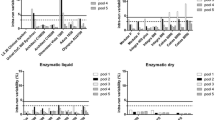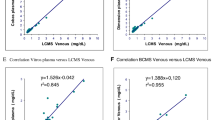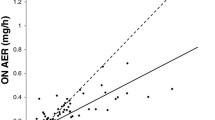Abstract
Urine albumin concentration and albumin–creatinine ratio are important for the screening of early-stage kidney damage. Commutable urine certified reference materials (CRMs) for albumin and creatinine are necessary for standardization of urine albumin and accurate measurement of albumin–urine ratio. Two urine CRMs for albumin and creatinine with certified values determined using higher-order reference measurement procedures were evaluated for their commutability on five brands/models of clinical analyzers where different reagent kits were used, including Roche Cobas c702, Roche Cobas c311, Siemens Atellica CH, Beckman Coulter AU5800, and Abbott Architect c16000. The commutability study was conducted by measuring at least 26 authentic patient urine samples and the human urine CRMs using both reference measurement procedures and the routine methods. Both the linear regression model suggested by the Clinical and Laboratory Standard Institute (CLSI) guidelines and log-transformed model recommended by the International Federation of Clinical Chemistry and Laboratory Medicine (IFCC) Commutability Working Group were used to evaluate the commutability of the human urine CRMs. The commutability of the human urine CRMs was found to be generally satisfactory on all five clinical analyzers for both albumin and creatinine, suggesting that they are suitable to be used routinely by clinical laboratories as quality control or for method validation of urine albumin and creatinine measurements.
Graphical Abstract








Similar content being viewed by others
References
Hutchison AS, O’Reilly DS, MacCuish AC. Albumin excretion rate, albumin concentration, and albumin/creatinine ratio compared for screening diabetics for slight albuminuria. Clin Chem. 1988;34:2019–21.
Jafar TH, Chaturvedi N, Hatcher J, Levey AS. Use of albumin creatinine ratio and urine albumin concentration as a screening test for albuminuria in an Indo-Asian population. Nephrol Dial Transplant. 2007;22:2194–200.
Hillege HL, Fidler V, Diercks GF, van Gilst WH, de Zeeuw D, van Veldhuisen DJ, et al. Urinary albumin excretion predicts cardiovascular and noncardiovascular mortality in general population. Circulation. 2002;106:1777–82.
Samak MJ, Levey AS, Schoolwerth AC, Coresh J, Culleton B, Hamm LL, et al. Kidney disease as a risk factor for development of cardiovascular disease: a statement from American Heart Association Councils on kidney in cardiovascular disease, high blood pressure research, clinical cardiology, and epidemiology and prevention. Hypertension. 2003;42:1050–65.
Yuyun MF, Khaw KT, Luben R, Welch A, Bingham S, Day NE, et al. Microalbuminuria independently predicts all-cause and cardiovascular mortality in a British population: the European prospective investigation into cancer in Norfolk (EPIC-Norfolk) population study. Int J Epidemiol. 2004;33:189–98.
Mann JF, Yi QL, Gerstein HC. Albuminuria as a predictor of cardiovascular and renal outcomes in people with known atherosclerotic cardiovascular disease. Kidney Int Suppl. 2004;92:S59-62.
Eknoyan G, Hostetter T, Bakris GL, Hebert L, Levey AS, Parving HH, et al. Proteinuria and other markers of chronic kidney disease: a position statement of the national kidney foundation (NKF) and the national institute of diabetes and digestive and kidney diseases (NIDDK). Am J Kidney Dis. 2003;42:617–22.
Chugh A, Bakris GL. Microalbuminuria: what is it? Why is it important? What should be done about it? An update J Clin Hypertens. 2007;9:99–102.
Levey AS, Coresh J, Balk E, Kausz AT, Levin A, Steffes MW, Hogg RJ, Perrone RD, Lau J, Eknoyan G. National kidney foundation practice guidelines for chronic kidney disease: evaluation, classification, and stratification. Ann Intern Med. 2003;139:137–47.
Seegmiller JC, Miller WG, Bachmann LM. Moving toward standardization of urine albumin measurements. EJIFCC. 2017;28:258–67.
International Consortium for Harmonization of Clinical Laboratory Results. Summary of measurand harmonization activities. https://www.harmonization.net/measurands/. Accessed 2 August.
Lieske JC, Bondar O, Miller WG, Bachmann LM, Narva AS, Itoh Y, et al. A reference system for urinary albumin: current status. Clin Chem Lab Med. 2013;51:981–9.
Standardisation of Albumin Assay in Urine (WG-SAU) - in collaboration with NIDDK. http://www.ifcc.org/ifcc-scientific-division/sd-working-groups/wg-sau/. Accessed: 2 August 2022.
Miller WG, Seegmiller JC, Lieske JC, Narva AS, Bachmann LM. Standardization of urine albumin measurements: states and performance goal. J Appl Lab Med. 2017;2:423–9.
Seegmiller JC, Barnidge DR, Burns BE, Larson TS, Lieske JC, Kumar R. Quantification of urinary albumin by using protein cleavage and LC-MS/MS. Clin Chem. 2009;55:1100–7.
Beasley-Green A, Burris NM, Bunk DM, Phinney KW. Multiplexed LC-MS/MS assay for urine albumin. J Proteome Res. 2014;13:3930–9.
Chen Y, Liu H, Loh TP, Liu Q, Teo TL, Lee TK, Sethi SK. Measurement of urine albumin by liquid chromatography-isotope dilution tandem mass spectrometry and its application to value assignment of external quality assessment samples and certification of reference materials. Clin Chem Lab Med. 2021;59:711–20.
Siekmann L. Determination of creatinine in human serum by isotope dilution-mass spectrometry. J Clin Chem Clin Biochem. 1985;23:137–44.
Dodder NG, Tai SSC, Sniegoski LT, Zhang NF, Welch MJ. Certification of creatinine in a human serum reference material by GC-MS and LC-MS. Clin Chem. 2007;53:1694–9.
Frasella S, Cremer KD, Coucke W, Glorieux G, Vanmassenhove J, Schepers E, et al. Development and validation of an ultra-high performance liquid chromatography–tandem mass spectrometry method to measure creatinine in human urine. J Chromatogr B. 2015;988:88–97.
SRM 3667 – Creatinine in frozen human urine. https://www-s.nist.gov/srmors/view_detail.cfm?srm=3667. Accessed 2 August 2022.
Vesper HW, Miller WG, Myers GL. Reference materials and commutability. Clin Biochem Rev. 2007;28:139–47.
Miller WG, Greenberg N, Budd J, Delatour V. The evolving role of commutability in metrological traceability. Chin Chim Acta. 2021;514:84–9.
Camara JE, Wise SA, Hoofnagle AN, Williams EL, Carter GD, Jones J, et al. Assessment of serum total 25-hydroxyvitamin D assay commutability of standard reference materials and College of American Pathologists Accuracy-Based Vitamin D (ABVD) Scheme and Vitamin D External Quality Assessment Scheme (DEQAS) materials: Vitamin D Standardization Program (VDSP) Commutability Study 2. Anal Bioanal Chem. 2021;413:5067–84.
Liu H, Wong L, Yong S, Liu Q, Teo TL, Lee TK, et al. Commutable whole blood reference materials for hemoglobin A1c validated on multiple clinical analyzers. Clin Chem Lab Med. 2019;57:648–58.
CLSI. Characterization and qualification of commutable reference materials for laboratory medicine; Approved Guideline. CLSI document EP30-A. Wayne: Clinical and Laboratory Standards Institute; 2010.
CLSI. Evaluation of Commutability of Processed Samples; Approved Guideline – Third Edition. CLSI document EP14-A3. Wayne: Clinical and Laboratory Standards Institute; 2014.
CLSI. Evaluation of Commutability of Processed Samples. 4th ed. CLSI guideline EP14. Clinical and Laboratory Standards Institute; 2022.
Miller WG, Schimmel H, Rej R, Greenberg N, Ceriotti F, Burns C, et al. IFCC Working Group recommendations for assessing commutability. Part 1: general experimental design. Clin Chem. 2018;64:447–54.
Nilsson G, Budd JR, Greenberg N, Delatour V, Rej R, Panteghini M, et al. IFCC Working Group recommendations for assessing commutability. Part 2: using the difference in bias between a reference material and clinical samples. Clin Chem. 2018;64:455–64.
Ceriotti F, Fernandez-Calle P, Klee GG, Nordin G, Sandberg S, Streichert T, et al. Criteria for assessing laboratory measurands to models for analytical performance specifications defined in the 1st EFLM Strategic Conference. Clin Chem Lab Med. 2017;55:189–94.
Braga F, Panteghini M. Performance specifications for measurement uncertainty of common biochemical measurands according to Milan models. Clin Chem Lab Med. 2021;59:1362–8.
The Royal College of Pathologists of Australia Quality Assurance Programs. Chemical pathology analytical performance specifications. https://rcpaqap.com.au/resources/chemical-pathology-analytical-performance-specifications. Accessed 2 August.
Acknowledgements
The authors are grateful to the Health Sciences Authority, Singapore, for the support of this project. The authors would like to thank Ms. Yiting Chen from the Health Sciences Authority, Ms. Sim Zhong Wei from the National University of Singapore, and Ms. Norashikin Binte Rashid and Ms. Lee Miao Qiao Jaelyn from Parkway Laboratories for their contributions to this work. The authors would also like to thank Ms. Cheow Pui Sze for her valuable suggestion on statistics.
The use of anonymized leftover patient urine samples in this study complied with the Declaration of Helsinki.
Author information
Authors and Affiliations
Corresponding author
Ethics declarations
Conflict of interest
The authors declare no competing interests.
Additional information
Publisher's note
Springer Nature remains neutral with regard to jurisdictional claims in published maps and institutional affiliations.
Supplementary Information
Below is the link to the electronic supplementary material.
Rights and permissions
Springer Nature or its licensor (e.g. a society or other partner) holds exclusive rights to this article under a publishing agreement with the author(s) or other rightsholder(s); author self-archiving of the accepted manuscript version of this article is solely governed by the terms of such publishing agreement and applicable law.
About this article
Cite this article
Liu, H., Ng, C.Y., Liu, Q. et al. Commutability assessment of human urine certified reference materials for albumin and creatinine on multiple clinical analyzers using different statistical models. Anal Bioanal Chem 415, 787–800 (2023). https://doi.org/10.1007/s00216-022-04472-y
Received:
Revised:
Accepted:
Published:
Issue Date:
DOI: https://doi.org/10.1007/s00216-022-04472-y




